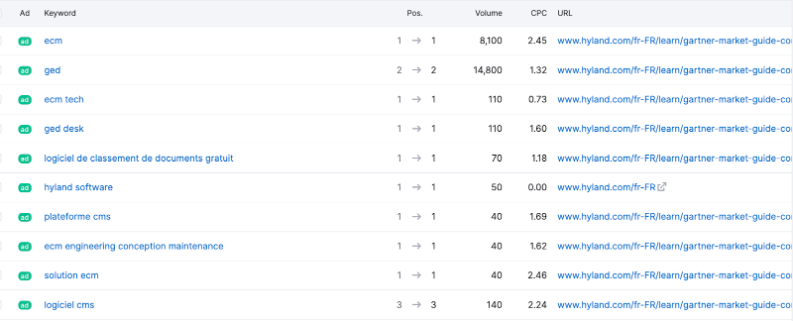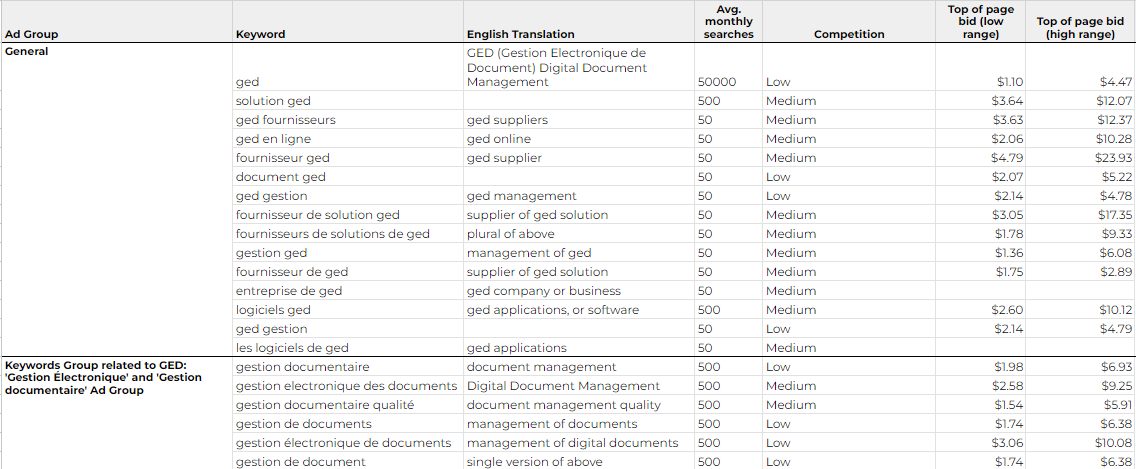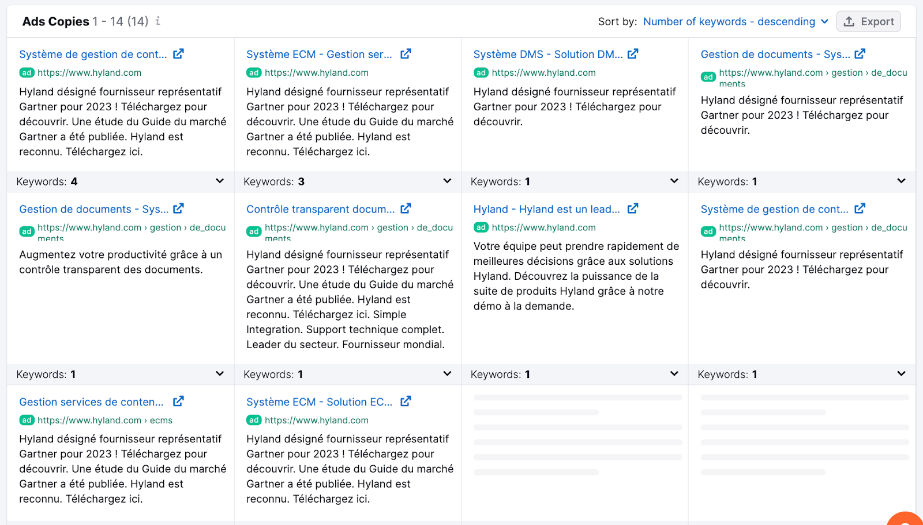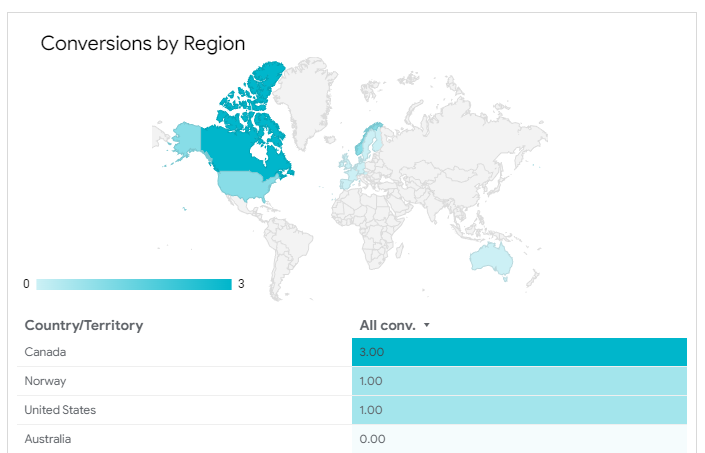SEO
Scale Your B2B Google Ads Strategy Across Multiple Languages

Humans are incredibly diverse – and it’s marketing’s job to respect, engage, and nurture that.
Expanding a B2B business from English-only strategies to regional, multi-language campaigns can absolutely be the turning point of your success. In fact, it’s hard to believe that not everyone’s taking advantage of it.
Mass-market, English-only campaigns cost a ton of money. And, with today’s expectation for a high level of personalization across the customer experience, they don’t really bring much to the table.
Multi-language ad campaigns are more effective as a whole and can even help save you money over time.
Why?
Because diverse markets help diversify income and lead to long-term business sustainability.
As more people throughout the world recognize your brand, you have the opportunity to build brand authority and reduce customer acquisition costs.
This is especially true if you’re in the B2B world. Larger deal sizes and complex buyer committees mean longer sales cycles and more opportunities to either impress or irritate local audiences.
And one of the best ways to turn this opportunity into reality is through the strategic use of localized Google Ad campaigns.
Because Google Ads drive conversions quickly, you can show proof of concept to new markets, which establishes a great starting point for long-term international expansion and increased ROI.
Let’s now dive into how this all works.
Localization > Translation
Before you load up 100 new Google Ad campaigns for your B2B target market, there’s one crucial concept to integrate into your processes: Focus on localization over translation.
Here’s a basic overview of the difference:
- Translation involves putting the exact keyword into Google Translate or Deepl and getting literal, word-for-word translations back. I don’t know if you’ve ever tried that when traveling around, but it doesn’t get you much further than asking for directions to the nearest restroom. And when applied to PPC, chances are that directly translated keywords either don’t have search volume or mean something entirely different when used in search (bringing about search intent mismatch).
- Localization is the act of identifying keyword intent and finding an equivalent with search volume in the target language of your choice. To do this, you’ll need to deeply understand the local market, its nuances, and the language they use.
Remember, local competitors are already matching local buyer expectations, so if you don’t start off by already doing that better, you won’t have much success. You can’t copy/paste global campaigns and then sit back, wondering why you’re not seeing the conversions roll in.
Mass website translation alone is not international expansion, and it’s often an efficient use of time and resources when there’s no localized strategy to back it up.
Steps For Developing A Multilingual PPC Strategy For B2B
Developing a multi-language Google Ad strategy takes time, but with the right approach, you can see success rather quickly.
Here, I’ll go through eight steps to help you scale your B2B business across multiple languages and regions.
Step 1: Localize Your Operations
Many companies successfully localize their marketing but forget to make changes when it comes to sales and operations (which actually need to be in place before marketing begins in order to guarantee ROI from the marketing efforts).
The reality is that people buy things differently in different countries. For example, in the US, you can purchase almost anything with a credit card, but in Germany, people don’t use them and much prefer payment by invoice.
The buying cycle in Germany is also much longer in B2B because the work culture is highly process-oriented.
If you don’t localize those areas and expect leads to talk to a salesperson in English with a 9-hour time difference, you definitely won’t do well in closing those leads that marketing has worked so hard to get.
To truly be successful when entering new markets, here are the elements you’ll want to localize:
| Brand Strategy | Buyer Personas | Content | Operations |
| Your USPs | Pain points | SEO keywords | Sales and customer service |
| Your competitors | Buying process & customer journey | Important words and phrases | Product |
| Messaging & cultural relevance | Buying obstacles and how to overcome them | Website in the local language | Payment process |
Step 2: Localize Market Research And Competitors
The next essential step when scaling your multi-language B2B Google ads strategy is to spend time actually learning about your target audience in local markets.
Rather than copy/pasting a generic global strategy, you need to see what brands resonate with locals and which local companies are seeing success.
To help you navigate this process, follow these steps:
- Start by exploring the competition within your chosen market and see what they’re doing to market to local audiences. You can gain access to key metrics using tools like Semrush Advertising Research to see if your competitors are running any paid ads and what keywords they’re bidding on.
To give you a visual idea, the screenshot above shows an example of PPC competitor research solely in the Swedish market.
This is useful because you’ll likely see that not all competitors have localized sites, which is an opportunity that major competitors have missed – good news for you and your niche!
- Then use Semrush Advertising Research to dig into the keywords competitors are bidding on and the types of pages they are using to target these keywords. It’s important to note that some companies may offer a similar service or product but may not necessarily be direct competitors, so you’ll need to filter out any who don’t match.
 Screenshot from Semrush, July 2023
Screenshot from Semrush, July 2023From this screenshot above for the French market, you can see that one competitor is bidding on a mix of French and English keywords, such as their brand “hyland software.”
- Lastly, take a look at what the competitor’s ad copy looks like. This will give you insight into the types of phrasing used and give you ideas for what you can improve on (as it should always be the goal to surpass competitors, not just match them).
 Screenshot from Semrush, July 2023
Screenshot from Semrush, July 2023This particular example shows how the competitor has only used English ads for the Norwegian market.
So there’s again an opportunity for you to offer a better customer experience through localization and target local keywords so that your Google Ads have a better quality score.
Overall, the more thorough you are with localized market and competitor research, the better you’ll be prepared to implement tactics that enable you to outpace them.
Step 3: Localize PPC Keyword Research
All local markets have some element of variation between them, which means that you can’t directly translate keywords. Direct translations don’t capture the differences between search intent among various languages, dialects, and regions.
This is where the concept of localization becomes absolutely crucial.
To effectively localize keywords, follow this process:
- Adapt keywords for localized PPC strategies by identifying keywords that match search intent and have search volume. If you don’t check local search volume and consider similar phrases, it’s easy to lose valuable conversions due to linguistic nuances.
- Interestingly, don’t overlook the power of English keywords as well as localized keywords. Some markets may have English keywords with more search volume than the localized language, and you’ll need to ensure you have ads running for both languages. I’ve found this to be especially true for the B2B tech industry that uses English phrases within the local language.

 Screenshots from author, July 2023
Screenshots from author, July 2023For example, in the screenshots above, you can see that document management keywords have been compiled in both Swedish and English. All the keywords came back with different search volumes, but there’s enough to warrant campaigns in both languages.
Note that the keyword “EDMS” is not used in Sweden, so consequently isn’t included in the chosen keywords for Sweden – hence the importance of understanding the market nuances through localization!
 Screenshot from author, July 2023
Screenshot from author, July 2023Another example of the importance of localization is the term “GED,” a common French abbreviation of the word “gestion électronique de documents.”
This is why you can’t just simply translate English keywords, as some of the highest search volume and conversion-focused keywords may end up being excluded from your strategy.
Step 4: Localize PPC Ad Copy
Ad copy localization is where it pays to collaborate with someone who speaks the native language. You’ll need to localize ad copy for the following:
- Brand messaging guidelines.
- Google Ad character limits.
- Local unique selling points (USPs).
- Local pain points.
- Local cultural nuances, both within the language and keywords targeted.
If you were to write ad copy for some of the French keywords compiled in the previous section, it might look like this:
 Screenshot from Semrush, July 2023
Screenshot from Semrush, July 2023Step 5: Localize PPC Landing Pages
The copy across the pages needs to contain local keywords in order to maintain a high-quality score (the higher the quality score, the lower the bid costs are).
You’ll also need to focus on addressing the different issues or pain points audiences have across different regions.
To stand out from your competition, prioritize your USP within that particular market. Creative angles can help engage new markets, especially when in comparison with local competitors.
Furthermore, make sure to add some social proof to your landing page. This can be anything from case studies, testimonials, or use cases that match the target audience market. Social proof, in particular, helps your message resonate more strongly.
Step 6: Organize PPC Ad Groups Based On Purchase Intent Stage
Once you have your landing pages localized, you’ll want to organize ad groups based on which part of the sales funnel they’re in, i.e. their level of purchase intent.
A successful Google Ad strategy creates content for and targets keywords based on both transactional and informational search intent.
To organize your campaigns accordingly, use the following steps:
- Define your keywords based on transactional search intent. These will be keywords that precisely describe your products and services and are most oriented toward direct lead generation (or contact with sales).
 Screenshot from author, July 2023
Screenshot from author, July 2023For example, the keywords above describe the main services that a compliance management company wants to run ads for. They’re very conversion-focused and capture the user when they’re looking to make a purchase.
- Then, define your keywords based on informational search intent. These will be keywords that describe topics that your audience needs information on and are relevant for selling your products and services, but your audience isn’t quite ready to buy yet. These types of ads are particularly useful for nurturing users toward conversion in combination with retargeting campaigns.
Splitting out campaigns like this allows you to manage budgets better, as informational keywords tend to be higher in value due to search volume and broadness. However, you still want to own this space to help nurture users toward conversion, so we do need ads here.
And with the correct bid strategy, you can ensure you get the most clicks within your budget. Targeting keywords with both types of intents is more successful than just going for direct conversions, as that can limit your return on investment (ROI) potential over time.
Step 7: Retarget Users To Choose Your Brand Once They’re Ready To Purchase
Once you’re organized, make a strategy for retargeting campaigns. To give you a visual, retargeting display ads often have a structure that looks like this:
 Image created by author, July 2023
Image created by author, July 2023Even though there typically is a CTA, remember that retargeting display campaigns aren’t for directly generating clicks.
When combined with the full funnel campaign approach, they’re meant to keep your brand and products/services top of mind.
Essentially, display ad retargeting is basically like going, “Hey, I’m here whenever you need something. Don’t forget me!”
So you’ll often see an increase in direct website traffic and branded keyword search volume from display ads, as opposed to direct click conversions.
Step 8: Track Multilingual PPC Performance Per Individual Markets
Finally, make sure that you set up conversion tracking for each market, not just globally.
This enables you to determine which markets perform best and where you might need to improve. Some ways to do this include ad campaign performance KPI tracking and conversions per region, such as shown in the below example images:
 Screenshots from author, July
Screenshots from author, July
Use Localization Within Your Multilingual PPC Strategy To Convert
If you want to expand your B2B business into international markets with Google Ads – and truly see your efforts pay off – you need to stop the Google Translation use and focus on holistically localizing your strategy.
In doing so, you have the opportunity to make a real, valuable impression on your target audience by matching local customer expectations while also gaining their trust and building your customer base.
While this process does require more effort, it’s a whole lot more effective for generating leads and ensuring that they actually close.
More resources:
Featured Image: Billion Photos/Shutterstock
SEO
How To Write ChatGPT Prompts To Get The Best Results

ChatGPT is a game changer in the field of SEO. This powerful language model can generate human-like content, making it an invaluable tool for SEO professionals.
However, the prompts you provide largely determine the quality of the output.
To unlock the full potential of ChatGPT and create content that resonates with your audience and search engines, writing effective prompts is crucial.
In this comprehensive guide, we’ll explore the art of writing prompts for ChatGPT, covering everything from basic techniques to advanced strategies for layering prompts and generating high-quality, SEO-friendly content.
Writing Prompts For ChatGPT
What Is A ChatGPT Prompt?
A ChatGPT prompt is an instruction or discussion topic a user provides for the ChatGPT AI model to respond to.
The prompt can be a question, statement, or any other stimulus to spark creativity, reflection, or engagement.
Users can use the prompt to generate ideas, share their thoughts, or start a conversation.
ChatGPT prompts are designed to be open-ended and can be customized based on the user’s preferences and interests.
How To Write Prompts For ChatGPT
Start by giving ChatGPT a writing prompt, such as, “Write a short story about a person who discovers they have a superpower.”
ChatGPT will then generate a response based on your prompt. Depending on the prompt’s complexity and the level of detail you requested, the answer may be a few sentences or several paragraphs long.
Use the ChatGPT-generated response as a starting point for your writing. You can take the ideas and concepts presented in the answer and expand upon them, adding your own unique spin to the story.
If you want to generate additional ideas, try asking ChatGPT follow-up questions related to your original prompt.
For example, you could ask, “What challenges might the person face in exploring their newfound superpower?” Or, “How might the person’s relationships with others be affected by their superpower?”
Remember that ChatGPT’s answers are generated by artificial intelligence and may not always be perfect or exactly what you want.
However, they can still be a great source of inspiration and help you start writing.
Must-Have GPTs Assistant
I recommend installing the WebBrowser Assistant created by the OpenAI Team. This tool allows you to add relevant Bing results to your ChatGPT prompts.
This assistant adds the first web results to your ChatGPT prompts for more accurate and up-to-date conversations.
It is very easy to install in only two clicks. (Click on Start Chat.)
For example, if I ask, “Who is Vincent Terrasi?,” ChatGPT has no answer.
With WebBrower Assistant, the assistant creates a new prompt with the first Bing results, and now ChatGPT knows who Vincent Terrasi is.
 Screenshot from ChatGPT, March 2023
Screenshot from ChatGPT, March 2023You can test other GPT assistants available in the GPTs search engine if you want to use Google results.
Master Reverse Prompt Engineering
ChatGPT can be an excellent tool for reverse engineering prompts because it generates natural and engaging responses to any given input.
By analyzing the prompts generated by ChatGPT, it is possible to gain insight into the model’s underlying thought processes and decision-making strategies.
One key benefit of using ChatGPT to reverse engineer prompts is that the model is highly transparent in its decision-making.
This means that the reasoning and logic behind each response can be traced, making it easier to understand how the model arrives at its conclusions.
Once you’ve done this a few times for different types of content, you’ll gain insight into crafting more effective prompts.
Prepare Your ChatGPT For Generating Prompts
First, activate the reverse prompt engineering.
- Type the following prompt: “Enable Reverse Prompt Engineering? By Reverse Prompt Engineering I mean creating a prompt from a given text.”
 Screenshot from ChatGPT, March 2023
Screenshot from ChatGPT, March 2023ChatGPT is now ready to generate your prompt. You can test the product description in a new chatbot session and evaluate the generated prompt.
- Type: “Create a very technical reverse prompt engineering template for a product description about iPhone 11.”
 Screenshot from ChatGPT, March 2023
Screenshot from ChatGPT, March 2023The result is amazing. You can test with a full text that you want to reproduce. Here is an example of a prompt for selling a Kindle on Amazon.
- Type: “Reverse Prompt engineer the following {product), capture the writing style and the length of the text :
product =”
 Screenshot from ChatGPT, March 2023
Screenshot from ChatGPT, March 2023I tested it on an SEJ blog post. Enjoy the analysis – it is excellent.
- Type: “Reverse Prompt engineer the following {text}, capture the tone and writing style of the {text} to include in the prompt :
text = all text coming from https://www.searchenginejournal.com/google-bard-training-data/478941/”
 Screenshot from ChatGPT, March 2023
Screenshot from ChatGPT, March 2023But be careful not to use ChatGPT to generate your texts. It is just a personal assistant.
Go Deeper
Prompts and examples for SEO:
- Keyword research and content ideas prompt: “Provide a list of 20 long-tail keyword ideas related to ‘local SEO strategies’ along with brief content topic descriptions for each keyword.”
- Optimizing content for featured snippets prompt: “Write a 40-50 word paragraph optimized for the query ‘what is the featured snippet in Google search’ that could potentially earn the featured snippet.”
- Creating meta descriptions prompt: “Draft a compelling meta description for the following blog post title: ’10 Technical SEO Factors You Can’t Ignore in 2024′.”
Important Considerations:
- Always Fact-Check: While ChatGPT can be a helpful tool, it’s crucial to remember that it may generate inaccurate or fabricated information. Always verify any facts, statistics, or quotes generated by ChatGPT before incorporating them into your content.
- Maintain Control and Creativity: Use ChatGPT as a tool to assist your writing, not replace it. Don’t rely on it to do your thinking or create content from scratch. Your unique perspective and creativity are essential for producing high-quality, engaging content.
- Iteration is Key: Refine and revise the outputs generated by ChatGPT to ensure they align with your voice, style, and intended message.
Additional Prompts for Rewording and SEO:
– Rewrite this sentence to be more concise and impactful.
– Suggest alternative phrasing for this section to improve clarity.
– Identify opportunities to incorporate relevant internal and external links.
– Analyze the keyword density and suggest improvements for better SEO.
Remember, while ChatGPT can be a valuable tool, it’s essential to use it responsibly and maintain control over your content creation process.
Experiment And Refine Your Prompting Techniques
Writing effective prompts for ChatGPT is an essential skill for any SEO professional who wants to harness the power of AI-generated content.
Hopefully, the insights and examples shared in this article can inspire you and help guide you to crafting stronger prompts that yield high-quality content.
Remember to experiment with layering prompts, iterating on the output, and continually refining your prompting techniques.
This will help you stay ahead of the curve in the ever-changing world of SEO.
More resources:
Featured Image: Tapati Rinchumrus/Shutterstock
SEO
Measuring Content Impact Across The Customer Journey

Understanding the impact of your content at every touchpoint of the customer journey is essential – but that’s easier said than done. From attracting potential leads to nurturing them into loyal customers, there are many touchpoints to look into.
So how do you identify and take advantage of these opportunities for growth?
Watch this on-demand webinar and learn a comprehensive approach for measuring the value of your content initiatives, so you can optimize resource allocation for maximum impact.
You’ll learn:
- Fresh methods for measuring your content’s impact.
- Fascinating insights using first-touch attribution, and how it differs from the usual last-touch perspective.
- Ways to persuade decision-makers to invest in more content by showcasing its value convincingly.
With Bill Franklin and Oliver Tani of DAC Group, we unravel the nuances of attribution modeling, emphasizing the significance of layering first-touch and last-touch attribution within your measurement strategy.
Check out these insights to help you craft compelling content tailored to each stage, using an approach rooted in first-hand experience to ensure your content resonates.
Whether you’re a seasoned marketer or new to content measurement, this webinar promises valuable insights and actionable tactics to elevate your SEO game and optimize your content initiatives for success.
View the slides below or check out the full webinar for all the details.
SEO
How to Find and Use Competitor Keywords

Competitor keywords are the keywords your rivals rank for in Google’s search results. They may rank organically or pay for Google Ads to rank in the paid results.
Knowing your competitors’ keywords is the easiest form of keyword research. If your competitors rank for or target particular keywords, it might be worth it for you to target them, too.
There is no way to see your competitors’ keywords without a tool like Ahrefs, which has a database of keywords and the sites that rank for them. As far as we know, Ahrefs has the biggest database of these keywords.
How to find all the keywords your competitor ranks for
- Go to Ahrefs’ Site Explorer
- Enter your competitor’s domain
- Go to the Organic keywords report
The report is sorted by traffic to show you the keywords sending your competitor the most visits. For example, Mailchimp gets most of its organic traffic from the keyword “mailchimp.”


Since you’re unlikely to rank for your competitor’s brand, you might want to exclude branded keywords from the report. You can do this by adding a Keyword > Doesn’t contain filter. In this example, we’ll filter out keywords containing “mailchimp” or any potential misspellings:


If you’re a new brand competing with one that’s established, you might also want to look for popular low-difficulty keywords. You can do this by setting the Volume filter to a minimum of 500 and the KD filter to a maximum of 10.


How to find keywords your competitor ranks for, but you don’t
- Go to Competitive Analysis
- Enter your domain in the This target doesn’t rank for section
- Enter your competitor’s domain in the But these competitors do section


Hit “Show keyword opportunities,” and you’ll see all the keywords your competitor ranks for, but you don’t.


You can also add a Volume and KD filter to find popular, low-difficulty keywords in this report.


How to find keywords multiple competitors rank for, but you don’t
- Go to Competitive Analysis
- Enter your domain in the This target doesn’t rank for section
- Enter the domains of multiple competitors in the But these competitors do section


You’ll see all the keywords that at least one of these competitors ranks for, but you don’t.


You can also narrow the list down to keywords that all competitors rank for. Click on the Competitors’ positions filter and choose All 3 competitors:


- Go to Ahrefs’ Site Explorer
- Enter your competitor’s domain
- Go to the Paid keywords report


This report shows you the keywords your competitors are targeting via Google Ads.
Since your competitor is paying for traffic from these keywords, it may indicate that they’re profitable for them—and could be for you, too.
You know what keywords your competitors are ranking for or bidding on. But what do you do with them? There are basically three options.
1. Create pages to target these keywords
You can only rank for keywords if you have content about them. So, the most straightforward thing you can do for competitors’ keywords you want to rank for is to create pages to target them.
However, before you do this, it’s worth clustering your competitor’s keywords by Parent Topic. This will group keywords that mean the same or similar things so you can target them all with one page.
Here’s how to do that:
- Export your competitor’s keywords, either from the Organic Keywords or Content Gap report
- Paste them into Keywords Explorer
- Click the “Clusters by Parent Topic” tab


For example, MailChimp ranks for keywords like “what is digital marketing” and “digital marketing definition.” These and many others get clustered under the Parent Topic of “digital marketing” because people searching for them are all looking for the same thing: a definition of digital marketing. You only need to create one page to potentially rank for all these keywords.


2. Optimize existing content by filling subtopics
You don’t always need to create new content to rank for competitors’ keywords. Sometimes, you can optimize the content you already have to rank for them.
How do you know which keywords you can do this for? Try this:
- Export your competitor’s keywords
- Paste them into Keywords Explorer
- Click the “Clusters by Parent Topic” tab
- Look for Parent Topics you already have content about
For example, if we analyze our competitor, we can see that seven keywords they rank for fall under the Parent Topic of “press release template.”


If we search our site, we see that we already have a page about this topic.


If we click the caret and check the keywords in the cluster, we see keywords like “press release example” and “press release format.”


To rank for the keywords in the cluster, we can probably optimize the page we already have by adding sections about the subtopics of “press release examples” and “press release format.”
3. Target these keywords with Google Ads
Paid keywords are the simplest—look through the report and see if there are any relevant keywords you might want to target, too.
For example, Mailchimp is bidding for the keyword “how to create a newsletter.”


If you’re ConvertKit, you may also want to target this keyword since it’s relevant.
If you decide to target the same keyword via Google Ads, you can hover over the magnifying glass to see the ads your competitor is using.


You can also see the landing page your competitor directs ad traffic to under the URL column.


Learn more
Check out more tutorials on how to do competitor keyword analysis:
-

 PPC6 days ago
PPC6 days ago19 Best SEO Tools in 2024 (For Every Use Case)
-

 MARKETING7 days ago
MARKETING7 days agoEcommerce evolution: Blurring the lines between B2B and B2C
-
SEARCHENGINES5 days ago
Daily Search Forum Recap: April 19, 2024
-
SEARCHENGINES6 days ago
Daily Search Forum Recap: April 18, 2024
-

 WORDPRESS5 days ago
WORDPRESS5 days agoHow to Make $5000 of Passive Income Every Month in WordPress
-

 SEO6 days ago
SEO6 days ago2024 WordPress Vulnerability Report Shows Errors Sites Keep Making
-

 WORDPRESS6 days ago
WORDPRESS6 days ago10 Amazing WordPress Design Resouces – WordPress.com News
-
WORDPRESS7 days ago
[GET] The7 Website And Ecommerce Builder For WordPress















